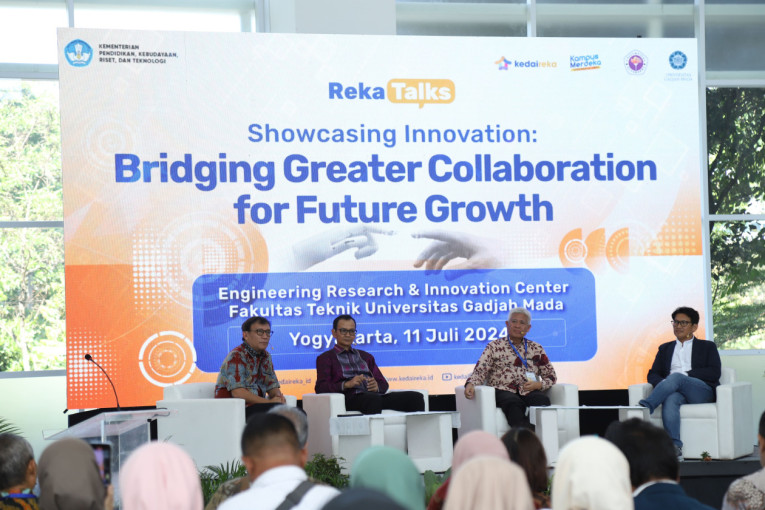
As many as 18 innovation results developed by lecturers from various universities were showcased at RekaTalks, themed “Showcasing Innovation: Bridging Greater Collaboration for Future Growth,” at the Engineering Research and Innovation Center (ERIC) of the Faculty of Engineering (FT UGM) on Thursday (Jul. 11).
This exhibition of various innovative products is the result of the Kedaireka program from the participants of the 2023 Dana Padanan Program (PDP), which has been curated.
From these eighteen innovation products funded by the Kedaireka matching fund, four of them feature innovations by UGM lecturers, including:
- Biodegradable Polypropylene Product: This is an alternative material to conventional plastic for food packaging and plastic bags. Dr. Yuni Kusumastuti, a lecturer in Chemical Engineering at FT UGM, developed this innovation. The advantage of this product is its increased degradation rate, allowing it to break down more quickly than conventional plastic.
- Immunobooster for Livestock: Developed by Professor Ali Agus from the Faculty of Animal Science, this product is a supplement to enhance the productivity and health of cattle and sheep. It contains ingredients such as corn, copra, palm kernel meal, corn gluten meal, cassava flour, wheat bran, molasses, palm oil, mineral premix, and vitamin premix.
- Toxin Binder: Created by Dr. Musin Al Anas from the Faculty of Animal Science, this innovation reduces toxins in poultry feed contaminated by Aspergillus flavus mold. Mold can easily affect feed, typically corn and grains with high moisture content. This additional product is intended to reduce toxin levels, with 2 kg per ton mixed into the feed.
In addition to innovations from UGM researchers, innovations from other universities were also showcased, such as:
- Canker Sore Plaster: Developed by Professor Nasrul Wathoni from Universitas Padjajaran, this product uses natural polysaccharide-based technology (chitosan and alginate) and has the potential to help treat canker sores.
- Anti-Aging Skincare: Developed by Professor I Ketut Adnyana from Bandung Institute of Technology, this product uses a hydrolyzed eggshell membrane as an anti-aging serum ingredient.
In the RekaTalks talk show, Professor Nizam of FT UGM and former Director General of Higher Education stated that the matching fund program, now renamed PDP, originated from industries’ low commitment to collaboration with universities in research and development.
Professor Nizam expressed gratitude that Indonesia’s ranking has improved significantly since the program began. According to the 2023 Global Innovation Index report by the World Intellectual Property Organization (WIPO), Indonesia ranks 5th globally in university-industry collaboration out of 132 countries.
“In 2020, we were still ranked 35th in the world,” he explained.
The improved index of innovation collaboration between campuses and industries domestically has also boosted Indonesia’s ranking from 85th in 2020 to 61st in 2023.
According to Professor Nizam, this increase in ranking is closely related to the hard work of campuses in establishing collaborations with industries through the Kedaireka program, which funds industry partnerships.
“Each year, the ministry funds 1,000 campus-industry collaborations, in addition to promoting Science Techno Parks at several campuses,” he said.
Professor Nizam emphasized that this improved ranking must be maintained and enhanced through extensive collaboration to build innovations through research and development programs.
“I think this momentum must continue. If we cannot sustain it, the ranking may drop again,” the professor asserted.
He believes that if Indonesia wants to become a developed country, it must strengthen its human resources to be competitive, excellent, and innovation-based. Therefore, universities must work together and build an innovation climate supported by industry, trade, and SMEs.
Professor Basarudin, a member of the PDP expert Team, stated that the PDP has raised campus awareness about building collaborations with industries.
“Such collaborations are becoming institutionalized, which is encouraging and should be appreciated,” Professor Basarudin said.
However, he believes that building promising innovations through interdisciplinary cooperation is equally important, as innovation users and industries always utilize innovations from research activities involving interdisciplinary research.
Author: Gusti Grehenson

